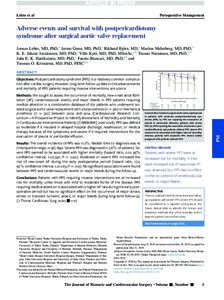Adverse events and survival with postpericardiotomy syndrome after surgical aortic valve replacement
Fausto Biancari; Markus Malmberg; Tuomas O. Kiviniemi; Joonas Lehto; Ville Kytö; Tuomo Nieminen; Jarmo Gunn; Juha E.K. Hartikainen; K.E. Juhani Airaksinen; Rikhard Björn
Adverse events and survival with postpericardiotomy syndrome after surgical aortic valve replacement
Fausto Biancari
Markus Malmberg
Tuomas O. Kiviniemi
Joonas Lehto
Ville Kytö
Tuomo Nieminen
Jarmo Gunn
Juha E.K. Hartikainen
K.E. Juhani Airaksinen
Rikhard Björn
Elsevier
Julkaisun pysyvä osoite on:
https://urn.fi/URN:NBN:fi-fe2021042827093
https://urn.fi/URN:NBN:fi-fe2021042827093
Tiivistelmä
Objectives
Postpericardiotomy syndrome (PPS) is a relatively common complication after cardiac surgery. However, long-term follow-up data on the adverse events and mortality of PPS patients requiring invasive interventions are scarce.
Methods
We sought to assess the occurrence of mortality, new-onset atrial fibrillation (AF), cerebrovascular events, and major bleeds in PPS patients requiring medical attention in a combination database of 671 patients who underwent isolated surgical aortic valve replacement with a bioprosthesis (n = 361) or mechanical prosthesis (n = 310) between 2002 and 2014 (Cardiovascular Research Consortium—A Prospective Project to Identify Biomarkers of Morbidity and Mortality in Cardiovascular Interventional Patients [CAREBANK] 2016-2018). PPS was defined as moderate if it resulted in delayed hospital discharge, readmission, or medical therapy because of the symptoms; and severe if it required interventions for the evacuation of pleural or pericardial effusion.
Results
The overall incidence of PPS was 11.2%. Median time to diagnosis was 16 (interquartile range, 11-36) days. Severe PPS was diagnosed in 3.6% of patients. Severe PPS seemed to be associated with higher mortality (hazard ratio, 2.01; 95% confidence interval, 1.03-3.91; P = .040). Moderate or severe PPS increased the risk of new-onset AF during the early postoperative period (hazard ratio, 1.72; 95% confidence interval, 1.12-2.63; P = .012). No significant associations were found between PPS and cerebrovascular events or major bleeds during the follow-up.
Conclusions
Patients with PPS requiring invasive interventions are at increased risk for mortality unlike those with mild to moderate forms of the disease. PPS requiring medical attention is associated with a higher AF rate during the early postoperative period but has no significant effect on the occurrence of major stroke, stroke or transient ischemic attack, or major bleeds during long-term follow-up.
Kokoelmat
- Rinnakkaistallenteet [19218]
